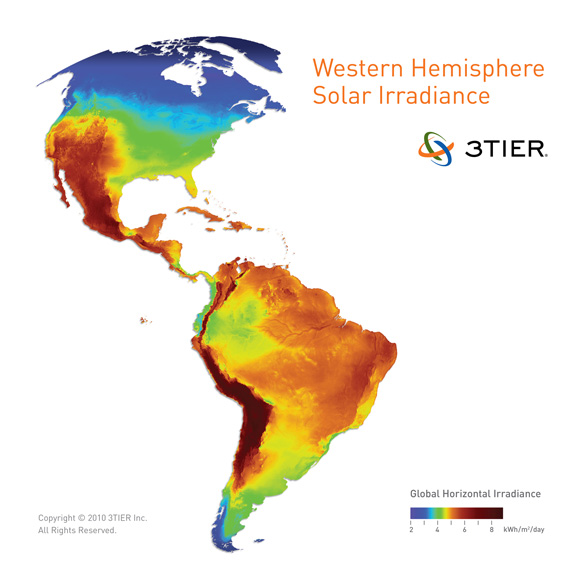An important part of increasing the use of solar power is to make the technology more economically feasible when compared to traditional power sources, such as fossil fuels, nuclear, and hydroelectric. One way to achieve this is to find the areas where solar irradiance is highest to ensure panels receive the largest amount of sunlight and thus power. One new and upcoming field, called solar forecasting, works to do just this by highlighting these areas on a global and local scale.
3TIER is a company that specializes in renewable energy risk analysis. They have produced a global solar radiation map which can be viewed below. We can see that the lower latitudes, such as the southwestern United States, clearly have more solar radiation. These regions will have a greater chance of being economical due to the greater amount of sunshine.

Solar forecasting is also growing at the University of California, San Diego. In the latest issue of Utility Products, the article “Solar Forecasting: The Next Big Thing for Solar Power?” by Jeff Postelwait highlights this industry at the school:
Solar forecasting as a technology is still in its infancy, and one place where it is being developed is at the University of California’s San Diego campus, where the Department of Energy is taking an interest (to the tune of a $1.93 million grant in 2010 with $500,000 cost share from the California Energy Commission) in developing ways to make solar energy more reliable through the use of forecasting techniques.
By using a device called a sky imager, the amount of solar radiation can be measured for a location. The imager also takes into account cloud cover. In regards to solar forecasting increasing the economical feasibility of using solar, Postelwait quotes Byron Washom, director of strategic energy initiatives at UC San Diego:
“We’re not lowering the cost of installed photovoltaics. We’re increasing the value that they will give to the market by increasing the predictability of the output. Large solar systems in the future will be bidding into an economic system, so if you’re wrong, it costs you money. This is why an annual average approach isn’t good enough,” Washom said.
With decreasing solar forecasting costs and a continued refining of the solar forecasting process, companies looking to invest in solar projects will have a better idea of where to place their solar panels and how best to place them at that location for a higher return on investment. In a competitive energy marketplace, these higher returns on investment will help put solar power out in front.







I see You’re really a excellent webmaster. This website loading speed is amazing.
It sort of feels that you’re doing any distinctive trick.
In addition, the contents are masterpiece. you have done a
wonderful activity in this topic! Similar here: <a href="[Link deleted]
and also here: <a href="[Link deleted]online
Howdy! Do you know if they make any plugins to help with SEO?
I’m trying to get my blog to rank for some targeted
keywords but I’m not seeing very good gains.
If you know of any please share. Thanks! I saw similar art here: <a href="[Link deleted]AA List